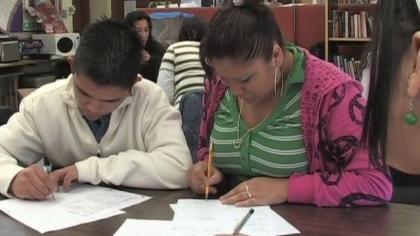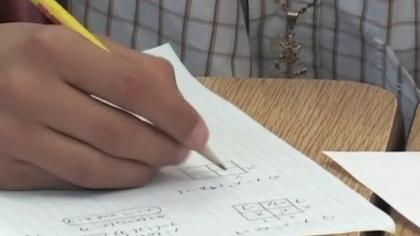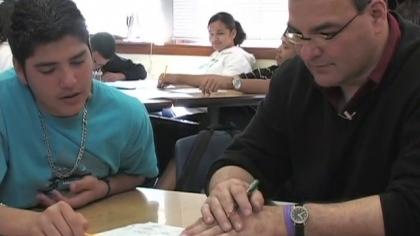Overview
I've been teaching for 24 years. Twenty of those I taught at San Leandro High School, which is where this lesson was filmed, and now I'm teaching at a small public school in Oakland.
This lesson was taped in a second semester Algebra 1 class, and it was a "sheltered" class, which at our school was predominantly for Spanish speakers. I always taught the English Language Learner "newcomers" so that I could reach the class bilingually. Usually within the first month and a half of the school year, I can leave behind most Spanish for most kids. But this particular class had so many newcomers that joined partway through the year that that was impossible.
I have always enjoyed working with teachers. It's the single most interesting piece of personal development that I do for myself, and I love connection. I think that helps me make and feel part of a broader community. When I started at San Lorenzo High School, it was around the time of math reform; as the math department we put together a set of ideas that I don't think very many other departments were putting together, and we were able to keep them together for the better part of 20 years. We worked heavily on having students work together in groups and had to learn a lot about how to make that function effectively. We looked everywhere we could, and we helped create curriculum that was group-worthy and that helps students change their perception of themselves as learners. And, at least until standardized testing came along, we looked pretty creatively at different forms of assessment that would not only give us a broader picture of what students knew, but also would help advance the curriculum in ways that were bigger than just "memorize these ideas." This was not an individual effort by any means. There were two or three dozen teachers that at one time or another contributed to the work at San Lorenzo.
In teaching and learning mathematics, the ideas that are most important to me are reasoning, justification, and connections among representations. In terms of justification, I never knew that math had to have reasons. I wasn’t a very good -- I’m still not a very good -- memorizer, so in my own education I had to construct ways of remembering things. Whenever I understood where something came from, that cut under my work quite a bit.
When I started teaching, I realized that was already in my head from my own experience, but I realized that I wasn’t alone in that regard, including that I didn’t know that that was a thing. I didn’t know that that made some sense of mathematics and something that a good math learner ought to do.
I found kids making lots of mistakes throughout because they didn’t have that understanding. At the same time, I realized that … this is where I’m thankful that I started when I did … that when I asked students questions that were more open-ended and more accessible by their intuition, they came up with amazing thinking that was very different from what I would have thought of. I learned a lot of mathematics just getting out of the way and listening to kids’ conjectures and ideas.
I found over time that the more I pushed for reasoning, more kids felt smart and accomplished, and I hear that in these videos quite a bit. There’s one, where there’s this spontaneous “oh!” and that’s a reaction I love. When I hear it, I realize not only that they’ve understood what’s going on, but they’ve bought into the process of understanding.
ABOUT THIS LESSON
In this lesson, we are working on reasoning and multiple representations around parabolas. Using multiple representations is one strategy I found to help make mathematics bigger for kids so that they can accomplish two things: One is so that they can have multiple points of access in from an idea, and the second is so that once they’ve done what they can initially from that point of access, that there’s more to think about that enriches their understanding of that idea. Because those representations can be tools: a graph can be a tool, an equation can be a tool, and a table can be a tool. This helps kids develop this orientation of "I understand these tools, and I’m going to bring them to bear on this new topic."
In these videos, students have had some exposure to factoring and multiplying, but it’s not automatic for any of them yet. They see how to find x and y intercepting with lines, but they’re clearly at a fairly procedural stage with that. They haven’t taken a step back and owned that whole concept for themselves yet.
They've made tables for parabolas and they can find the vertex in the table. That doesn’t mean that they see enough about a vertex to figure out how to find it starting from other information. What that means for me is that although they’re used to being able to do something that looks like going from algebra to the graphs, they’re not yet thinking in their heads, “I can make a graph if I have this information, so how can I get it from the algebra?” They’re not going backwards that way.
That, for me, is an example of trying to take what I think is a pretty dry, maybe uninteresting topic, and make it bigger somehow so that more kids have more to contribute. Very few kids understand the whole process, at least at the beginning.
TEACHER AS FACILITATOR
As I work with the students and circulate around the room during the class period, I really expect them to be able to figure out, configure, by themselves versus with help from me. In this lesson, I expected them to be able to bring the bits and pieces to the table but not necessarily be able to put it all together well. That’s because of where the lesson fell compared to their understanding of the content. It wasn’t exactly an exploratory lesson, but it was definitely not a synthesis lesson either. That means teaching them the difference between details that are worth putting down on paper because it’s mathematically important and communicative, and details that are okay to put down on paper but you don’t have to do it for me.
I’m also aware of which kids are feeling vulnerable and are perceived that way by others. I want to put them in the position of realizing that there are things that they’re smart about and helping their peers realize there are things that they’re smart about, so that they approach problems with growing confidence and they don’t see the places where they have holes or questions, or have something to hide or panic about. There are lots of ways in which kids are different from each other, not just in terms of their background, but mathematically. I feel like my job is to create curriculum and participation structures that bring those differences out, to demystify them.
BUILDING EQUITY AND SELF-EFFICACY IN THE CLASSROOM
In teaching, teachers can be tempted to say, “I want to make sure that no kid is quiet” as a proxy for everyone participating in the investigation somehow. That’s not necessarily accurate: it depends on what the kid is thinking about. Over time, you can tell when a kid is despairing of their ability to learn, and when a kid might be struggling but they do something about it on a routine basis, which I find heroic.
One of my students in this class thought of himself as the class clown. It was a challenge to let him be his goofy self because that was his source of social status, but to not let that goofiness be a replacement for hard work and effort, to draw the line when it comes time to really try. To his credit, he was able to do that. It’s his personality. He got positive reinforcement from lots of peers, so I don’t want abandon that, but I don’t want him to hide behind it either.
Another student is similar, but teeters more in the direction of playing around and giving up and not thinking of himself as confident and competent. He was a bigger challenge for me in that regard. In one clip where he appears he yells out, “See, I do know something.” That’s his agenda. He knows that he’s got reason to hope, he just doesn’t have enough evidence for it yet. He knows it’s an agenda. He knows that there’s something that he’s supposed to be working out, even if he can’t some of it all the time.
Another student had an edge to him of, "am I going to get involved in gangs or am I going to go to school?" He really struggled with the math all the time, so I’d let him continue working at his own pace even though he wasn’t with his team. With him, I just needed to keep affirming, affirming, affirming, so that he didn’t quit, so that he would always put his head down and work. Unlike other kids where I wanted them to bring their questions and fears to the table, I didn’t need him to expose himself that way, I just needed him to keep working and to keep the dialog between the two of us. With some kids who, for whatever reason, it’s too much to ask them to believe in themselves right away. As a proxy for that, I want them to believe in me and in my ability to teach them and work with them and care for them, and then leverage from that over time to “Oh, I can do this by myself.”
show more














